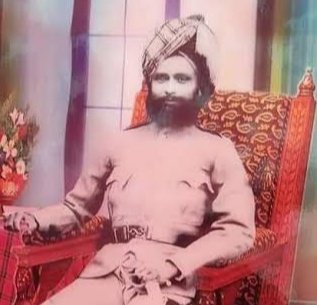A Thread🧵 on Amar Shaheed Bandhu Singh Shrinet (1833-1858), the fearless freedom fighter from Gorakhpur sho challeged British rule during the 1857 rebellion. (1/8) 

Bandhu Singh ji was born on the 1st of May , 1833 in Dumari Riyasat , Gorakhpur, into a Rajput Zamindar family of the Shrinet clan. He was the son of Babu Shiv Prasad Singh. He had five brother and deeply devoted Tarkhulha Devi , a deity he worshipped Fervantly. (2/8)
During the 1857 uprising , Bandhu Singh led guerrilla attacks against the British. He ambushed colonial officials in the forests near Gorakhpur, offering their heads at the Tarkhulha Devi Temple symbolising his resistance against oppression. (3/8)
His bold actions installed fear among the British. He even killed the British collector and sat on his chair, a defiant act against colonial authority. Despite extensive searches, his guerrilla tactics kept him elusive for a significant time. (4/8)
Eventually, betrayal led to his capture. Surat Singh, in exchange for a pension and land, informed the British of Bandhu Singh's whereabouts. He was arrested along with Shivgobind Chand from Chillupur , though Chand managed to escape to Nepal. (5/8)
On 12th August 1858, Bandhu Singh was publicly hanged at Ali Nagar Chauraha , Gorakhpur. Local lore says the British failed six times to hang him, only on the seventh attempt, after his invocation to Tarkhulha Devi, was the execution successful. (6/8)
His legacy endures in Gorakhpur. The Shaheed Bandhu Singh Smarak stands at his execution site. Annual fairs at the Tarkhulha Devi temple commemorate his sacrifice, attracting people from various regions to honor his memory. (7/8)
Special Cover was released on his 178th Birth Day (10th May 2010) by his direct descendant Senior Leader Late Shri Vinay Kumar Singh “Binnu” Ji and Yogi Adityanath from Gorakhpur. (8/8) 

@threadreaderapp unroll
• • •
Missing some Tweet in this thread? You can try to
force a refresh













